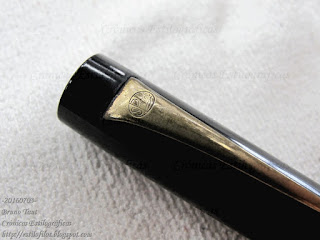
The Carving pen. On the barrel there is an engraving: "CARVING / MADE IN TOKYO".
Dimensions of the pen: length closed: 138 mm; length open: 124 mm; length posted: 154 mm; diameter: 10 mm; weight: 12.6 g.
Nothing do I know about the brand “Carving”. However, the shape of this particular model, and the geometry of the nib point out at the 1960s as the production time.

A gold plated stainless steel nib. The engraving is simple: "CARVING / JIS ". The geometry is similar to some nibs made by Pilot and Sailor during the 1950s and 1960s.

Inside, something that looks like a cartridge. The inscription reads "カービンオーツマン61 / 吸入もできるスペアー" (Carving ôtsuman 61 / inhalation spare).
Its filling system also suggests an intermediate time between the 1950s and 1980s—it is an interesting middle point between two known systems. The first of them is the pulsated piston Pilot named as A-shiki (system A) in the late 1940s. The second, obviously by now, is the CON-70 converter, also by Pilot, currently on production.
On the first system –A-shiki–, the whole pumping action is driven from the tail, and a sliding sheath in the internal rod acts as stopper preventing the ink from going out on the downward movement of the system.
The CON-70 acts in a similar fashion. Now the sealing valve is a rubber part that moves quite freely along the metallic rod in the central axis of the converter. And the basic difference with the system A is the spring that retracts the piston automatically. Well, and the fact that the CON-70, as a converter, can be detached from the pen.

A built-in CON-70 in a Pilot Custom (no additional number) from 1985. This filling system was also implemented on the Pilot Custom 65 (1983).
The “Carving” system implemented on the Carving pen works on the same principles: a pumping system and a closing valve. But now the pumping mechanism is a type of a sac, although on this case it is more of a plastic cartridge with some flexibility. The valve, on its side, moves freely inside the bladder, and seals it –partially— when pressing it. Carving called this “inhalation spare” and it makes some sense as the whole mechanism can be detached from the pen and could easily be replaced. I ignore, however, if the company marketed spare filling systems or had designed (and sold) more traditional –nominally disposable— cartridges.

The de-facto converter. The internal stopper is visible through the cracked plastic. The durability of this device is an obvious concern.
The fact that this “Carving” system was trivially detachable is, in itself, very interesting. First, because it shows that the time of the self-filling systems was ending and yielding its way to the disposable cartridge. Second, and more relevant here, because Pilot implemented the early versions of the later called CON-70 as built-in, non-removable filling systems on a couple of models in the early 1980s. In this regard, the Carving pen was well ahead of its time.
But it is also a small anecdote in the history of Japanese pens.
My thanks to Mr. Sugimoto.
Minka Saturn – Diamine China Blue
Bruno Taut
Nakano, May 2018
labels: Pilot, Carving, soluciones técnicas, conversor
Bruno Taut
Nakano, May 2018
labels: Pilot, Carving, soluciones técnicas, conversor



























































